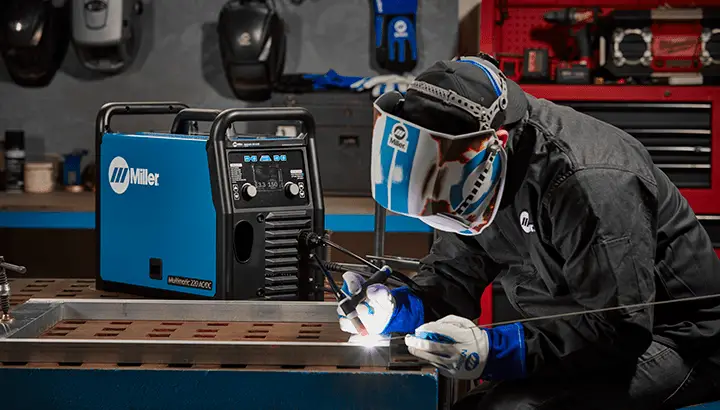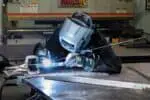Aluminum welding is not an easy task even for an expert welder. The unique characteristics of the silvery-white metal make the process a challenge.
Diving deeper, TIG welding aluminum has its own specialties, for the metal requires certain changes from the usual TIG welding processes to make up for its special attributes.
TIG welding Aluminium uses AC or Alternating Current and not a specific type. This is because of the oxide layer that the metal has. Breaking this oxide layer is crucial for the metal to be welded. And this is the core purpose of AC in TIG welding aluminum. Yet, there are certain drawbacks to this method.
Know more by reading further…
Why does TIG welding use AC for only Aluminum?
TIG welding normally uses DC for welding metals as the uninterrupted flow of electricity constantly in one direction ensures deep penetration irrespective of the thickness of the metal used. Moreover, the arc will not get extinguished every other second giving a good flow to the process.
But, when it comes to aluminum the preference goes for AC without much thought. This is because of the capability of Alternating Current to destroy the oxide layer that wraps the metal. The layer has a higher melting point than the metal creating quite a dilemma for the welder.
When the metal only requires a temperature close to 600 degrees Celsius to melt, the oxide layer might take a temperature up to 2000 degrees Celsius for the same.
Moreover, the oxide is heavier than the metal and hence when melted can get trapped in molten aluminum. To avoid the metal from burning up before the oxide layer, the latter must be destroyed or removed first. AC rightly serves this purpose with its alternating polarities.
In AC the direction of electricity continuously changes mirroring the same in the charge of the electrons. When the electrode is positive, the negative electrons travel from the metal piece to the rod resulting in the breakage of the oxide layer.
Following this electrons become positive and the electrode negative making the former move towards the workpiece from the latter generating enough heat for the penetration to happen. This way, the dilemma is traversed smoothly.
What is the downside of using AC to TIG weld aluminum?
AC is the best choice to weld aluminum in TIG, however, there are certain drawbacks of using this type of currency. They are:
Penetration capacity not enough for thick metals: Alternating Current is not known for its penetration capability.
The thickness of the aluminum used should not be more than ¼ inch thick or else the arc would not be able to lay the weld properly. The quick change in polarities does not give a consistent push for strong penetration.
Bead profile will not be up to the mark: TIG welding using AC gives a bead profile that is not much soothing to the eye.
Moreover, the big beads that are created can affect the perfection of the quality and integrity of the weld. The smaller the beads the faster the cooling of the weld.
What are the challenges of welding a TIG seam with aluminum in AC?
Welding with AC comes up with a bunch of challenges especially when aluminum is involved. Let’s see what they are.
1. Risk of oxidation: As mentioned earlier, the sensitive nature of aluminum puts it at the risk of reaction with oxygen leading to oxidation otherwise called rusting. Corrosion of the metal makes it brittle and unsuitable for any application let alone welding.
2. Sensitive nature: Aluminum being a sensitive metal can easily get contaminated with impurities. The metal during welding can get exposed to air and dirt leading to hindrance to the procedure.
If the metal comes in contact with hydrogen or oxygen from the atmosphere the quality and appearance of the weld can get altered in an irreversible way.
3. Tendency to be porous: When aluminum is heated, it tends to eat hydrogen from the atmosphere, leading to little bubbles being formed in the molten weld pool. Bubbles affect the integrity of the weld as they make it porous and weak.
4. Lack of knowledge: A welder should be able to gauge the thickness of the metal properly so that he can adopt the right way to weld.
It is true that AC might not be convenient in welding thick aluminum but it is not impossible. Doing multiple passes is a way of conquering thick metal.
The edges should be beveled and a root bead needs to be laid before the filler metal is added. The filler and cap passes should be done numerous times in order to get a strong joint.
What are the tips to weld aluminum with TIG in AC?
1. Don’t forget a heat sink: A heat sink is kept adjacent to a weld to ensure proper heat transfer. This is necessary for the TIG welder and the molten weld pool to be active thereby ensuring the best result. Transfer of heat ensures good penetration of the arc as well.
2. Keep the aluminum clean: Impurities on the metal can lead to troubles that can seriously affect the quality of the weld.
Hence, always remember to clean the metal thoroughly to avoid oxidation or disturbances that can develop as a result.
There are numerous ways through which this can be done. Check out the video below to see how you can prep your aluminum before welding.
3. Always preheat the metal: Preheating the metal will help in having a smooth weld. When the metal is not raw and has been touched by heat it tends to be more flexible for the welding procedure.
Moreover, it raises the overall temperature thereby reducing the cooling rate of the base material. It also helps in removing any water content on the metal.
4. Choose the right tungsten: As TIG welding is based primarily on the tungsten rods, make sure to choose your rod that fulfils your requirement.
Tungsten rods are coded with different colours depending on its constituents. For a detail understanding about the different tungsten rods.
5. Keep the settings under control: Always try not to go overboard with the task. For instance, welders often make the mistake of letting too much argon flow that can lead to arc instability. Prevent such flaws by being alert before, during, and after the process.
When is DC used to TIG weld aluminum?
Yes, using DC to TIG weld aluminum is not that rare. In fact, it is done for some specific requirements that are not possible with AC. DC is used when:
1. You are rooting for good penetration: As mentioned earlier, using AC might not be the best way to weld aluminum with considerable thickness.
Or you might have to spend more time to get a strong joint. With reverse polarity DC, these issues can be avoided. It gives good penetration even when the metal is thick.
2. You have to fix your aluminum: DC becomes the apt choice when you have to fix any gouges or pits in your metal.
This type of current when used can repair such problems speedily by filling such pits. Smoothen the surface using a grinder after the metal cools. This helps to rectify the unevenness of the metal.
3. To sharpen the electrode ends: Yes, DC is specifically used when the tungsten electrodes need to be balled up. This is done so that arc remains stable during AC welding. However, most of today’s welders come with a mechanism to shape electrodes.
To see how it is done check out the video given below:
Using DC has certain drawbacks as the following:
-
-
- Cannot break the oxide layer covering aluminum
- If the metal is highly covered with dirt DC will not be effective
- Does not have a good cleaning power as AC
- Cannot give good looking weld as much as AC
- Not suitable to join pieces of cast aluminum
-
See also: MIG Vs TIG Welding Aluminium: Which One is Better?
To Conclude
It is a widely accepted fact that to TIG weld aluminum, AC is the way to go due to its unique capabilities. Even when it has drawbacks in general, AC is the only type of current that can handle a confusing metal like aluminum.
If you liked this blog, do check out the rest of my writings.
Ciao!








